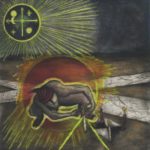
Eric K. Lerner is a self-taught artist. In the mid-1990’s he began creating votive pieces employing mixed media, acrylic, and digital manipulation. That work was first featured in the QuaQuaversal Minds Exhibition with Genesis P-Orridge, exploring transgressive spirituality, at the Clayton Powell Gallery, New York, 1998, which was favorably reviewed in the New York Times. Soon, he began working as a graphic designer and illustrator. His clients included the BBC, Science Magazine, IBM, Marriott Corporation and Right Hemisphere. He produced posters, t-shirts and publications for AIDS service providers and advocacy organizations, including: AIDS Research Information Center, Health Education Resource Organization, Maryland State Health Department, ACTUP, and the American Indian Center. By 2004, he stopped working in digital media almost entirely to focus on illustration work using traditional techniques. He also studied Buddhist thangka painting. By 2008, he realized that most of the works that initially inspired him to pursue the visual arts were old etchings, engravings and woodcuts. He turned his focus to traditional printmaking in 2010. As a fine artist, Lerner has exhibited and sold work in the United States, the U.K., Australia and continental Europe. His 2012 release of a hand-crafted major arcana tarot, Radiant Spleen Tarot, appeared to favorable reviews and sold out. He has work included in the permanent collection of the Museo dei Tarocchi in Bologna. In 2017, he contributed 5 pieces to Tarot 1917, commemorating the Russian Revolution, an international collaborative exhibition/publication that premiered in St. Petersburgh Russia on October 22, 2017 and later traveled to Madrid Spain. Currently, he publishes the counter-culture arts and literary journal The Biscuit (www.threebonessociety.com). His work is extensively profiled in Charlotte Rodgers’ The Bloody Sacrifice (Mandrake of Oxford) and numerous other book and print publications.


























































































A lot of my work portrays points in which liminal boundaries break down. Frequently, the triggers may be some type of sex, violence, outlandish behavior or tragedy. I don’t view these as sensational elements. Rather they are phenomena that depart from ordinary routine. The purpose of depicting them is to cause the viewer to examine the subject’s circumstance from a different perspective and thus intuit a point where boundaries between exoteric and esoteric reflect one another. Even though I operate often from a specific religious or narrative focus, I do not like explaining what is going on in an image explicitly. I’d rather the viewer create his or her own narratives. Often I find their interpretations more intriguing than my own.